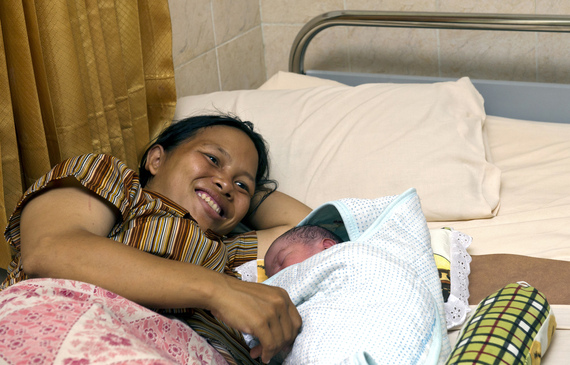The world is an extraordinarily different place than it was in 2000 when the Millennium Development Goals (MDGs) were established. Fifteen years after MDG 4 to reduce child mortality came into effect, the global child mortality rate has fallen by an outstanding 53%. And just over 10 years after Wellbeing Foundation Africa (WBFA) began its work in sub-Saharan Africa, child mortality has fallen by 48% in the region. Whilst there is a long way to go to ensure that this progress can be achieved in all regions and all countries, it is important to take this time to rejoice, reflect, and recalibrate.
At the upcoming United Nations General Assembly (UNGA), the Sustainable Development Goals (SDGs) will be finalised with attention turning towards implementation. Those of us working in global health and development will be exploring how we can achieve SDG 3 -- which seeks to "to ensure healthy lives and promote wellbeing for all, at all ages" -- a far-reaching goal with 13 specific targets to achieve by 2030. Progress on these targets must occur because for far too many people, the following scenario is far too common.
"Upon going into labour, your family is presented with a hospital bill of approx.$300 USD for a simple, uncomplicated delivery. The cost of delivery is just under 10% of the estimated per capita annual income and could cripple your family financially for years, resulting in further economic vulnerability and limited access to primary healthcare, setting off a cycle of poverty and poor health for generations."
This scenario is common across many sub-Saharan countries but this does not need to be the case. The cost of delivery varies around the world -- with free care provided to mothers in the UK and Norway -- two countries with the lowest maternal and child mortality rates. In Nepal -- one of the few countries to meet MDG targets on reducing maternal mortality -- women are, in fact, paid to attend antenatal appointments and to deliver in a hospital.
Access to free and universal healthcare is essential for mothers, their newborns, and young children. Pregnant women need regular care that can track health, prepare mothers for birth, and ensure that the baby is healthy and reaches their pivotal fifth birthday. In countries without a universal health coverage (UHC) system, access to primary healthcare can be prohibitively expensive, pricing out those who need it the most. Providing expectant mothers with antenatal treatment or classes in a respectful, dignified environment prepares women for birth by alleviating fears and ensuring that mothers are partners in the pregnancy process -- setting the course for Respectful Maternity Care (RMC). Moreover, a woman's need for information and willingness to make lifestyle changes is highest during pregnancy, thus antenatal treatment and education programmes delivered by qualified midwives as part of a global midwifery services framework can have an important impact on the health of mothers and children. It is vital that this treatment is provided for all mothers, in all countries, and as part of all health systems.
At WBFA, we understand that universal health coverage is not free and can never be free. Even in the UK, with a free National Health Service (NHS), care comes at a cost via a system of taxes and co-payments for prescriptions. Yet, this is an investment that governments must make for the health of their people - and this is now more important than ever. Within SDG 3, targets 3.7 and 3.8 relate specifically to universal access to sexual and reproductive healthcare services and universal health coverage, including access to family planning, financial risk protection, access to quality essential healthcare services, and affordable medicines and vaccines for all.
Hitting these targets is crucial because without them, ensuring healthy lives and wellbeing for all, at all ages, will be difficult. Without universal healthcare, a country's health infrastructure can vary significantly in quality, with an expensive two-tier system that leaves an entire class of people out in the cold, without dignified care. Governments - in collaboration with other health actors or sources of innovative financing for health, including the private sector and civil society - must take action towards a common purpose, and make a purposeful investment in universal health coverage to achieve SDG3.
Implementing universal healthcare is by no means easy but it is possible through collaboration with the private sector, civil society, and local communities. In March, WBFA and I introduced the Alaafia Universal Health Coverage Fund (AUHCF) to mark International Women's Day. In partnership with Hygeia Community Health Care, a Nigerian health insurance provider, and the PharmAccess Foundation, WBFA established the AUHCF. Through the AUHCF - a global best practices model - we fund insurance premiums for 5000 Nigerians each year. The AUHCF enables patients to access affordable primary health care, rather than relying primarily on expensive emergency care. This will in turn have a positive impact on overall health habits, encourage healthier home practices, and set Nigeria, well and truly on the road to dignity in the post-2015 development agenda.
Governments all over the world insure their buildings or assets from potential risk. Yet, why do so many governments refuse to similarly insure their citizens from the risks posed by a lack of preparedness in a country's health infrastructure and in the delivery of essential health services? Is the value of a human life -- of human dignity -- really less than that of a house? Introducing universal health coverage is not easy, nor is it cheap, but as shown in the MDG process, when we collaborate and innovate, we can achieve progress.
